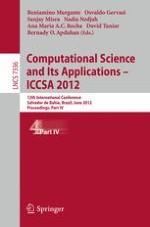The four-volume set LNCS 7333-7336 constitutes the refereed proceedings of the 12th International Conference on Computational Science and Its Applications, ICCSA 2012, held in Salvador de Bahia, Brazil, in June 2012. The four volumes contain papers presented in the following workshops: 7333 - advances in high performance algorithms and applications (AHPAA); bioinspired computing and applications (BIOCA); computational geometry and applicatons (CGA); chemistry and materials sciences and technologies (CMST); cities, technologies and planning (CTP); 7334 - econometrics and multidimensional evaluation in the urban environment (EMEUE); geographical analysis, urban modeling, spatial statistics (Geo-An-Mod); 7335 - optimization techniques and applications (OTA); mobile communications (MC); mobile-computing, sensind and actuation for cyber physical systems (MSA4CPS); remote sensing (RS); 7336 - software engineering processes and applications (SEPA); software quality (SQ); security and privacy in computational sciences (SPCS); soft computing and data engineering (SCDE). The topics of the fully refereed papers are structured according to the four major conference themes: 7333 - computational methods, algorithms and scientific application; 7334 - geometric modelling, graphics and visualization; 7335 - information systems and technologies; 7336 - high performance computing and networks.
